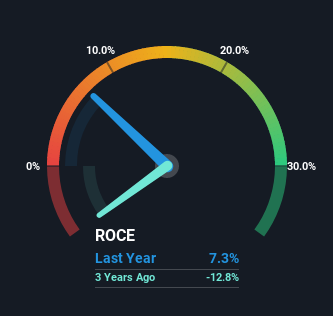If we want to find a potential multi-bagger, often there are underlying trends that can provide clues. Firstly, we'll want to see a proven return on capital employed (ROCE) that is increasing, and secondly, an expanding base of capital employed. If you see this, it typically means it's a company with a great business model and plenty of profitable reinvestment opportunities. Speaking of which, we noticed some great changes in China Tangshang Holdings' (HKG:674) returns on capital, so let's have a look.
What Is Return On Capital Employed (ROCE)?
Just to clarify if you're unsure, ROCE is a metric for evaluating how much pre-tax income (in percentage terms) a company earns on the capital invested in its business. The formula for this calculation on China Tangshang Holdings is:
Return on Capital Employed = Earnings Before Interest and Tax (EBIT) ÷ (Total Assets - Current Liabilities)
0.073 = HK$79m ÷ (HK$2.0b - HK$875m) (Based on the trailing twelve months to March 2022).
Therefore, China Tangshang Holdings has an ROCE of 7.3%. In absolute terms, that's a low return but it's around the Commercial Services industry average of 8.1%.
View our latest analysis for China Tangshang Holdings

While the past is not representative of the future, it can be helpful to know how a company has performed historically, which is why we have this chart above. If you're interested in investigating China Tangshang Holdings' past further, check out this free graph of past earnings, revenue and cash flow.
What Can We Tell From China Tangshang Holdings' ROCE Trend?
The fact that China Tangshang Holdings is now generating some pre-tax profits from its prior investments is very encouraging. About five years ago the company was generating losses but things have turned around because it's now earning 7.3% on its capital. Not only that, but the company is utilizing 703% more capital than before, but that's to be expected from a company trying to break into profitability. We like this trend, because it tells us the company has profitable reinvestment opportunities available to it, and if it continues going forward that can lead to a multi-bagger performance.
In another part of our analysis, we noticed that the company's ratio of current liabilities to total assets decreased to 45%, which broadly means the business is relying less on its suppliers or short-term creditors to fund its operations. This tells us that China Tangshang Holdings has grown its returns without a reliance on increasing their current liabilities, which we're very happy with. Nevertheless, there are some potential risks the company is bearing with current liabilities that high, so just keep that in mind.
What We Can Learn From China Tangshang Holdings' ROCE
To the delight of most shareholders, China Tangshang Holdings has now broken into profitability. Given the stock has declined 44% in the last five years, this could be a good investment if the valuation and other metrics are also appealing. So researching this company further and determining whether or not these trends will continue seems justified.
If you want to know some of the risks facing China Tangshang Holdings we've found 4 warning signs (1 can't be ignored!) that you should be aware of before investing here.
While China Tangshang Holdings may not currently earn the highest returns, we've compiled a list of companies that currently earn more than 25% return on equity. Check out this free list here.
New: AI Stock Screener & Alerts
Our new AI Stock Screener scans the market every day to uncover opportunities.
• Dividend Powerhouses (3%+ Yield)
• Undervalued Small Caps with Insider Buying
• High growth Tech and AI Companies
Or build your own from over 50 metrics.
Have feedback on this article? Concerned about the content? Get in touch with us directly. Alternatively, email editorial-team (at) simplywallst.com.
This article by Simply Wall St is general in nature. We provide commentary based on historical data and analyst forecasts only using an unbiased methodology and our articles are not intended to be financial advice. It does not constitute a recommendation to buy or sell any stock, and does not take account of your objectives, or your financial situation. We aim to bring you long-term focused analysis driven by fundamental data. Note that our analysis may not factor in the latest price-sensitive company announcements or qualitative material. Simply Wall St has no position in any stocks mentioned.
About SEHK:674
China Tangshang Holdings
An investment holding company, engages in the property investment, development, and sub-leasing activities in Hong Kong and the People’s Republic of China.
Flawless balance sheet and slightly overvalued.
Market Insights
Community Narratives



